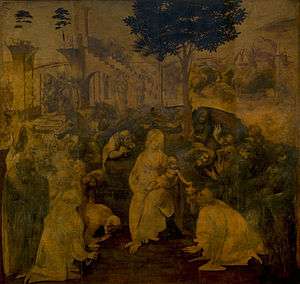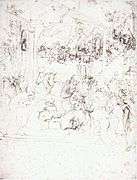Adoration of the Magi (Leonardo)
 | |
| Artist | Leonardo da Vinci |
|---|---|
| Year | 1481 |
| Type | oil on wood |
| Dimensions | 246 cm × 243 cm (97 in × 96 in) |
| Location | Uffizi, Florence |
The Adoration of the Magi is an early painting by Leonardo da Vinci. Leonardo was given the commission by the Augustinian monks of San Donato a Scopeto in Florence, but departed for Milan the following year, leaving the painting unfinished. It has been in the Uffizi Gallery in Florence since 1670.
Description
The Virgin Mary and Child are depicted in the foreground and form a triangular shape with the Magi kneeling in adoration. Behind them is a semicircle of accompanying figures, including what may be a self-portrait of the young Leonardo (on the far right). In the background on the left is the ruin of a pagan building, on which workmen can be seen, apparently repairing it. On the right are men on horseback fighting, and a sketch of a rocky landscape.
The ruins are a possible reference to the Basilica of Maxentius, which, according to Medieval legend, the Romans claimed would stand until a virgin gave birth. It is supposed to have collapsed on the night of Christ's birth (in fact it was not even built until a later date). The ruins dominate a preparatory perspective drawing by Leonardo, which also includes the fighting horsemen. The palm tree in the centre has associations with the Virgin Mary, partly due to the phrase 'You are stately as a palm tree' from the Song of Solomon, which is believed to prefigure her. Another aspect of the palm tree can be the usage of the palm tree as a symbol of victory for ancient Rome, whereas in Christianity it is a representation of martyrdom—triumph over death—so in conclusion we can say that the palm in general represents triumph. The other tree in the painting is from the carob family, the seeds from the tree are used as a unit of measurement. They measure valuable stones and jewels. This tree and its seeds are associated with crowns suggesting Christ as the king of kings or the Virgin as the future Queen of heaven, also that this is nature's gift to the new born Christ. As with Michelangelo's Doni Tondo the background is probably supposed to represent the Pagan world supplanted by the Christian world, as inaugurated by the events in the foreground.The artist uses bright colors to illuminate the figures in the foreground of the painting. Jesus and the virgin Mary are, in fact, painted yellow, the color of light. It is also interesting how the trees are painted blue, an unusual color for trees of any kind. On the right side the most credible self-portrait of Leonardo da Vinci as a 30 year old can be seen, according to several critics. See Angelo Paratico [1]
Much of the composition of this painting was influenced by an earlier work of the Northern artist Rogier van der Weyden. The relationship between figures, space and the viewer’s standpoint, the high horizon, slightly raised viewpoint, space receding into the far distance, and a central figural group poised before a rock formation in the middle of the landscape are all copied from van der Weyden's Entombment of Christ (1460, Uffizi Gallery, Italy).[2]
Other painters involved
Owing to the painting's unfinished status in 1481, the commission was handed over to Filippino Lippi, who painted another Adoration of the Magi, completed in 1496, in substitution of the one commissioned to Leonardo. It is housed in the Uffizi of Florence.
Domenico Ghirlandaio, completed a separate painting, expanding upon Leonardo's theme, in 1488.
In 2002, Dr. Maurizio Seracini, an art diagnostician alumnus of the University of California, San Diego and a native Florentine, was commissioned by the Uffizi to undertake a study of the paint-surface to determine whether the painting could be restored without damaging it. Seracini, who heads Editech, a Florence-based company he founded in 1977 focused on the “diagnostics of cultural heritage", used high-resolution digital scans as well as thermographic, ultra sound, ultra-violet and infrared diagnostic techniques to study the painting in ultra-fine detail. He concluded that the painting could not be restored without damaging it and that Leonardo only did the underdrawing. Another artist (or artists) was responsible for all of the existing paintwork on top of the underdrawing. Seracini stated that "none of the paint we see on the Adoration today was put there by Leonardo." As a part of his diagnostic survey on the Adoration of the Magi, Seracini completed more than 2,400 detailed infrared photographic records of the painting's elaborate underdrawing, and scientific analyses.[3] The new images revealed by the diagnostic techniques used by Seracini were initially made public in 2002 in an interview with New York Times reporter Melinda Henneberger.[4] In 2005, nearing the end of his investigation, Seracini gave another interview, this time to Guardian reporter John Hooper.[5] Seracini finally published his results in 2006 – M. Seracini, "Diagnostic Investigations on the Adoration of the Magi by Leonardo da Vinci" in The Mind of Leonardo – The Universal Genius at Work, exhibit catalogue edited by P. Gauluzzi, Giunti Florence, 2006, pp. 94–101.[6]
In the Smithsonian Channel TV program, Da Vinci Detective, Seracini conjectures that, upon seeing the preliminary drawings for the altarpiece they had commissioned, they rejected it due to the sensational scenario presented to them. Fully expecting a traditional interpretation including the three wise men, they were instead confronted with a maelstrom of unrelated, half-emaciated figures surrounding the Christ-Child, as well as a full blown battle scene in the rear of the picture. They chose instead to relegate it to a storage house, rather than to destroy the original work. It was only much later, and probably in the context of the subsequent rise in value of Leonardo artworks, that it was resurrected and painted over by unknown persons to make it more "sale-able." This later re-working of the panel resulted in alterations to Leonardo's original design for the piece.
Recently (2012–2013) the painting was under restoration at the Opificio delle Pietre Dure.
Related works
|
See also
References
- ↑ http://www.lascarpublishing.com/leonardo/
- ↑ V. Schmidt (ed), Italy and the Low Countries: artistic relations: the fifteenth century (Florence, 1999), pp. 49–51
- ↑ full presentation Archived September 28, 2007, at the Wayback Machine. by Florence.tv that shows Leonardo's underdrawing discovered by Seracini.
- ↑ "Leonardo Adoration of the Magi – Times Article". Library.thinkquest.org. 2002-04-21. Retrieved 2013-07-17.
- ↑ John Hooper in Rome (2005-09-20). "report". London: Guardian. Retrieved 2013-07-17.
- ↑ "Structural Engineering, University of California San Diego". Structures.ucsd.edu. Retrieved 2013-07-17.
Bibliography
Costantino, Maria (1994). Leonardo. New York: Smithmark.
External links
| Wikimedia Commons has media related to Adoration of the Magi by Leonardo da Vinci. |
- Image of the painting
- Editech srl, Diagnostic Center for Cultural Heritage
- Article in Physorg, 2006
- Rediscovering Leonardo, Osher UCSD Distinguished Lecture Series , June 2008
- Da Vinci Decoded, UCSD Alumni, Jan 2006
- Adoration of the Magi at the BBC
- Leonardo da Vinci: anatomical drawings from the Royal Library, Windsor Castle, exhibition catalog fully online as PDF from The Metropolitan Museum of Art, which contains material on Adoration of the Magi (see index)


